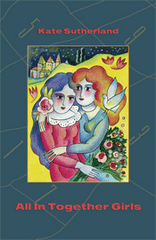Sherill Tippins, February House (Houghton Mifflin, 2005)
I confess that I’m a biography junkie. My favourites are literary biographies that not only illuminate the lives of the subjects at their centre but also evoke the creative communities of which those subjects were a part. Brad Gooch’s City Poet: The Life and Times of Frank O’Hara is a particularly stellar example. I came away from it with new insight into O’Hara, keen to reread his work, and I was also inspired to pick up books by the other poets of the New York School, and to seek out artwork by the denizens of the Cedar Tavern.
You would think then that biographies that focus on groups rather than individuals would be tailor-made for me. Alas, more often than not, I’ve found such books to be a disappointment. I like there to be a story in my life stories, and group biographies rarely have a sufficient centre to hold the narrative together. Frequently they degenerate into a series of individual mini-biographies that are only tenuously and rather artificially connected to one another.
Happily, February House by Sherill Tippins is that rare creature, a group biography that works brilliantly. It tells the story of an experiment in communal living when a group of young writers, artists, and musicians came together under one roof at 7 Middagh Street in Brooklyn in the year leading up to the US entry into WWII. The instigator of the experiment was writer, editor and all-round literary impresario George Davis. Inmates of the household included Carson McCullers, W.H. Auden, Gypsy Rose Lee, Benjamin Britten, and Jane and Paul Bowles.
The genius of this book lies in its organizing premise. The Middagh Street household, the core members together with the many others who moved through or hung about on the fringes, adds up to a staggeringly large and diverse group for any biographer to contend with. But by maintaining a discrete focus on the particular place and time that brought the group together, Tippins is able to analyse their lives and work in sufficient detail to provide readers with new insight into each individual as well as into their connections with and differences from one another.
The group was drawn together by their creative aspirations and a common desire for a cheap and congenial space in which to pursue them. Yet there were significant distinctions between them: in their chosen art forms, in their creative processes, and in their politics and philosophies. Because she doesn’t artificially gather them together under the banner of a single school of thought, Tippins is able to treat the members of the Middagh Street household as a group without ever glossing over the very significant differences between them.
We see members of the household inspiring, encouraging and mentoring one another. Auden took snippets from the dinner table conversation and transformed them into some of his best poems. When Carson McCullers was stuck in the middle of what that was to become The Member of the Wedding, a childhood story from Chester Kallman (Auden’s lover) provided her with the moment of epiphany that got the novel back on track. Later, a couple that McCullers came across while frequenting the seedy bars of nearby Sands Street with Davis and Auden inspired The Ballad of the Sad Café. Under George Davis’ tutelage, Gypsy Rose Lee produced her first book, The G-String Murders: The Story of a Burlesque Girl. Over lengthy conversations in the parlour, Auden helped Jane Bowles to find the confidence to write her novel, Two Serious Ladies. We also see inmates of the house thwarting and impeding one another’s work. For example, Britten and Paul Bowles were driven mad by the sounds of each other’s pianos to the extent that Bowles, the more recent arrival, was ultimately evicted.
All of this was occurring against the backdrop of the war raging in Europe. Tensions between the members of the household were heightened given the very different ideas they had or were developing about the roles and responsibilities of artists in wartime. They (and their friends, family members, and colleagues) were very differently situated in relation to the war: there were European refugees, anxious to bring Hitler’s evil to the attention of apathetic Americans; expatriate Brits who were being soundly criticized by those at home who felt they were evading their responsibilities; and, of course, the not-yet-at-war Americans who were divided on whether and how their country should enter the fray.
In this hothouse atmosphere, some of the members of the household, for example McCullers and Auden, produced or conceived of some of their best work. For others, the year on Middagh Street was a failed experiment but nonetheless a formative experience. For example, Britten needed to make a break with Auden (after their disastrous collaboration on the operatta Paul Bunyan) and return to Britain before he hit his creative stride and wrote his first great opera, Peter Grimes.
February House fascinated me and left me wanting more. Not because the book was incomplete, but because Tippins so thoroughly drew me in that I feel compelled now to dig deeper into the lives of her subjects, to find out more about what happened to them before and after their Middagh Street days and, more importantly, to immerse myself in their work.
Subscribe to:
Post Comments (Atom)

2 comments:
This really does sound good. Thanks for leaving a link to your post! Have you read "Poets in Their Youth," about Lowell, Jarrell, and others? Very good, also.
Excellent review. The book really does leave you with that sense of longing to delve deeper into their respective work. (I found a copy of Auden's collection of essays, The Dyer's Hand soon after reading it.)
Post a Comment